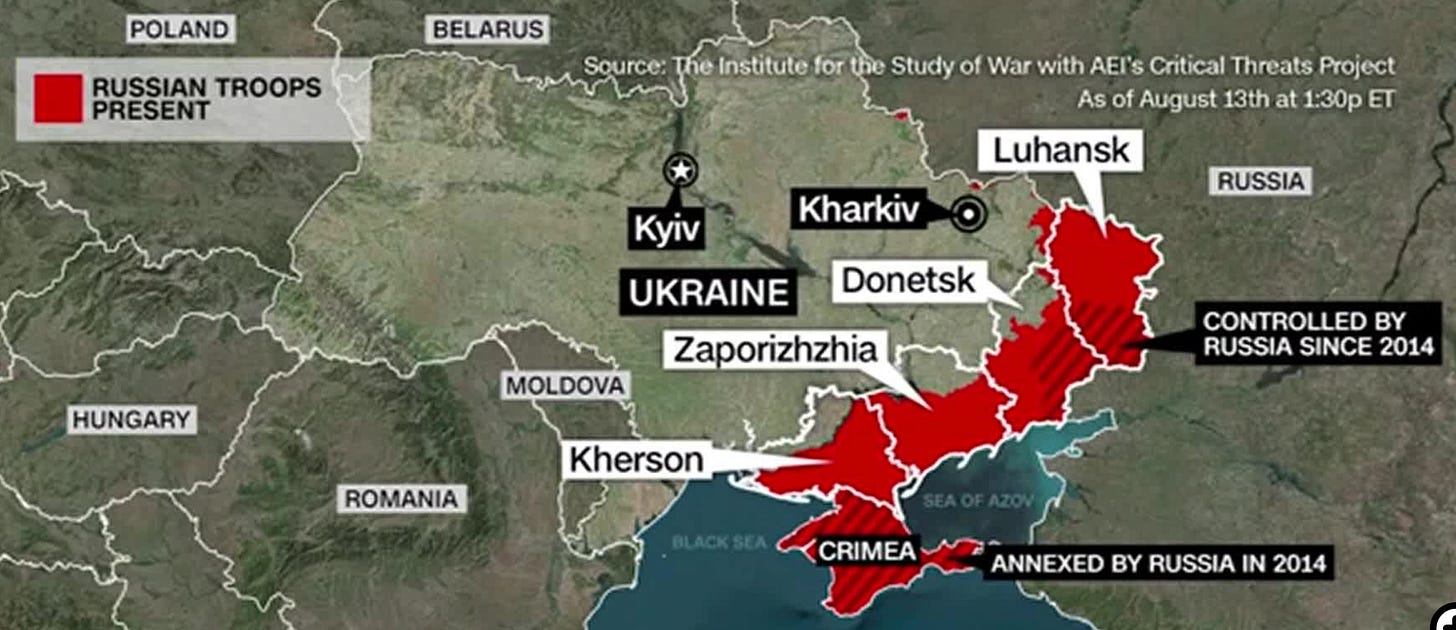Dementia-Ridden Cognitively-Addled Chaos-Monkey Causes Chaos at Alaska Summit
A ceasefire-in-place in Ukraine might—might—be a way of stopping the atrocity of the death and destruction in the war Putin’s Russia is waging against Ukraine. A ceasefire in return for Ukraine (and Europe) agreeing to redraw the border to recognize Russia as legal ruler of all of the Donbas, not just to recognize Russia as ruler of the Crimea and those parts of the Donbas it has conquered, is clearly not. For, then, the same factors that have led Putin to continue his failed war would still be operative, and might well lead him to start it up again in a year, launching new attacks from his now-advanced positions…
The first thing to note is that Jim Tankersley, Ivan Nechepurenko, and Steven Erlanger of the New York Times are simply not competent at their jobs. They write (I’m not going to link) that Putin demanded and Trump agreed that for a ceasefire Ukraine should “give up the rest of the Donbas region to Russia”. Putin demanded (in addition to Crimea) all of the oblasts of Kherson, Zaporizhzhia, Donetsk, and Luhansk. The Donbas region consists of the oblasts of Donetsk and Luhansk (plus part of the Rostov oblast in Russia). The Donbas is defined by the Don coal basis after which it is named, and the industrial history centered on Donetsk and Luhansk that was sprung out of that coal resource.
Yes, it was that bad. And the New York Times has no business sanewashing it. Dan Pfeiffer has views, with which I agree:
Dan Pfeiffer: How to Make Trump Pay for Bending the Knee to Putin (Again) <https://www.messageboxnews.com/p/how-to-make-trump-pay-for-bending>: ‘Trump gets played for a fool on the world stage (again)…. The Alaska summit with Vladimir Putin was all about creating an image of Trump standing astride the world stage. Trump’s mindset is frozen in amber in the 1980s. He pictured himself playing the role of Ronald Reagan at the major summits with Mikhail Gorbachev…. As with most things related to Trump, it was a stylistic win and a massive substantive loss…. Trump got totally played…. Trump may have loved the images, but Putin—a war criminal—being welcomed to the United States on a literal red carpet was a massive win for Russia. And it gets much worse….
“Trump on Saturday split from Ukraine and key European allies… backing Mr. Putin’s plan for a sweeping peace agreement based on Ukraine ceding territory it controls to Russia, instead of the urgent cease-fire Mr. Trump had said he wanted…. Trump told European leaders that he believed a rapid peace deal could be negotiated if Mr. Zelensky agreed to give up the rest of the Donbas region to Russia, even those areas not occupied by Russian troops….”… This is what happens when you send a naive, suggestible, aging reality star into a meeting with a KGB operative turned dictator. There is so much to say about this stunning—but not shocking—capitulation from Trump…
Had Trump, afterwards, declared: “Ceasefire-in-place, and Putin agrees to NATO training battalions in Ukraine near the line,” I would have applauded—maybe even leapt from my seat. That would have been a clear, bold shift in the region’s security. NATO trainers near the front line would have given Kyiv not just skills, but protection, rhyming with NATO's 2010s moves into the Baltics and Poland, which did deter Russia successfully. NATO’s presence would have served as a tripwire, as in the Cold-War Era’s Berlin Brigade, a small U.S. force that stood there not to help win a war if one began, but to stop one beginning. Moreover, it would have built on Ukraine's efforts since 2014 to rebuild its military from scratch—a hybrid force that has shown resilience but remains limited. That would have meant a real commitment to Ukraine’s security and Europe's stability.
That is not what we got.
Had Trump, afterwards, declared: “Ceasefire-in-place, and then we will engage in difficult and protracted negotiations, because there is little agreement,” I would not have called it a disaster. That kind of statement reflects how diplomacy often begins. Ceasefires buy time. They stop immediate violence, and open space for talks. Admittedly, such talks do not usually involve a dementia-ridden cognitively-addled chaos-monkey as a principal. But what we are, we are. We can no longer expect to move heaven and earth.
The Korean Armistice in 1953, while not a final peace, stopped major fighting. The Dayton Accords started with a ceasefire too. They ended the Bosnian War. Trump admitting talks would be hard and slow would have been rare honesty—and welcome. Acknowledging disagreement up front shows realism It would have marked a break from his usual focus on show over substance. It wouldn’t have been a breakthrough, but it would have been normal—and that alone would have been an improvement.
But that, too, is not what we got.
This smells like a replay of Trump’s Afghanistan exit: he pulls out, claiming a deal, though nothing was negotiated. In 2020, Trump signed an agreement with the Taliban that promised U.S. withdrawal in return for vague Taliban promises. The Afghan government wasn’t even at the table. There were no real enforcement terms. Trump called it a peace deal. But the Taliban kept fighting. This is without substance, without allies, without a plan. This is not a strategy. This is abandonment, papered over with slogans.
In Afghanistan, by the time the U.S. pulled out, there was no center that existed to resist the Taliban. The government was weak, corrupt, and dependent on U.S. support. When that support vanished, local leaders and officials cut their own deals with the Taliban. Provinces fell without a fight. Army units gave up or disappeared. The Taliban’s sweep wasn’t just about force. It was about filling a power vacuum. Ghani’s government had no legitimacy and couldn’t rally defense. Everyone looked out for themselves, and the state collapsed. What followed was chaos, evacuation, Taliban rule, and a deepening crisis. Two decades of war hadn’t built anything that could stand on its own.
Now, what happens next is out of U.S. hands. With Washington stepping back, leadership has shifted to Berlin, Paris, Brussels, Warsaw, and Kyiv. NATO unity, EU resolve, and Ukraine’s strength now shape the future. Europe might manage Russian aggression, energy pressure, and Ukraine’s path westward. But we’ve seen what happens when Europe, to put it politely, “hesitates”, as in the Balkans in the 1990s. But today’s Europe is more assertive and invested than 1990s Europe was. Whether it acts in concert or falls into division will decide what comes next. The drivers are no longer in D.C., but across the Atlantic.
Is Europe a superpower—or even a true regional power? The EU is an economic giant, rivaling the U.S. in market size and influence. But militarily and diplomatically, it falls short. There’s no EU army. Foreign policy needs consensus among 27 states with competing interests. Europe struggles to act anywhere, whether the Balkans or across the Mediterranean, or Ukraine. In Ukraine, its response, though strong, has so far leaned on U.S. leadership. A superpower shapes outcomes on its own. Europe has the resources, but not the unity. Whether it can become a real power is still an open question.
Can Europe commit to doing what it takes to keep Ukraine independent? That requires long-term aid, lots of weapons, lots of cash, and political backing—and for years upon years. The EU has pledged billions and started accession talks, a major shift. But real commitment also means sacrifice: higher energy costs, more defense spending, and facing down internal political opposition. Europe must accept that its post-Cold War peace dividend is over.
But Ukraine’s fate isn’t just about Ukraine. It is about Europe’s own security. The real question is: can Europe afford not to commit?
Look: I understand the Muscovite narrative here, what “justifies” not just the current war but the 2014 Crimea blitzkrieg and the grinding in the Donbas from then until now. There is a clear, if historically distorted, narrative rooted in grievance and nostalgia.
The first core claim was simple: Crimea had been “stolen.” In the 1950s Khrushchev transferred it from the Russian to the Ukrainian SSR as a political-bureaucratic stunt. “Some fool stole it from us in the 1950s,” went the refrain.
The second core claim made the case for backing separatists in eastern Ukraine—Donetsk, Luhansk, Kharkiv. These were Russified regions, settled from the north and east during the tsarist and Soviet periods. Russian language, labor, and culture predominated. Why weren’t they part of Russia? The Kremlin’s answer reaches back to Lenin and Stalin. Under early Soviet nationalities policy, Moscow created republics with ethnic identities—Ukraine among them—to manage diversity and buy loyalty. Lenin insisted Ukraine exist as a distinct republic. Stalin followed.
This policy was always double-edged. It promoted ethnicity, but only under central control. It created nations—not to empower them, but to keep them quiet. As Terry Martin argues in The Affirmative Action Empire, the USSR was never post-national. It was a managed empire of identities.
And, for Ukraine, Lenin defined its borders historically: as the sum of the right-bank and left-bank territories of the Cossack Hetmanate of Bohdan Khmelnytsky when he pledged loyalty to the Tsar at Pereyaslav in 1654, plus the territories further south to the Black Sea, Novorossiya—New Russia—conquered from the Ottomans by Count Potemkin for Tsarina Yekaterina II Velikaya and then settled primarily by Russian-speakers from the north.
The result, for Ukraine, the result was borders that included heavily Russian-speaking areas within a Ukraine committed to its own Ukraine language and culture.
After 1991, Ukraine kept its Soviet borders. Over time, it leaned west. Language laws changed. EU and NATO ties grew. To Putin, this was betrayal. His response: to claim Ukraine was never a real country—just a Soviet administrative error, now manipulated by the West.
So what we’ve seen is not just war, but an imperial state trying to rewrite its borders—and history. A century-old nationality policy, meant to manage difference, now serves as the script for undoing sovereignty.
And we shall see what comes next. Nothing is inevitable. Ukraine’s future, and Europe’s, will be shaped by will, strategy, and resolve. And no, the next six months are not likely to be decisive.

